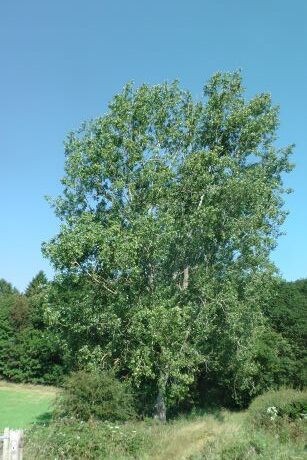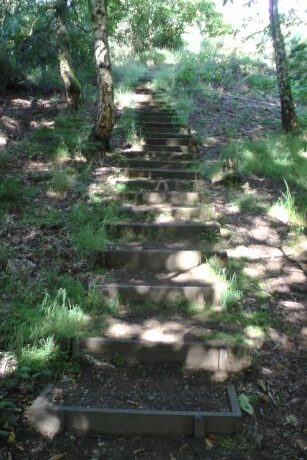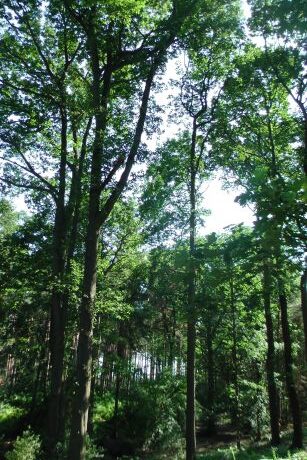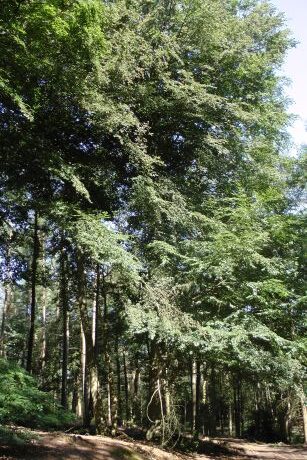A walk through Aspley Guise
by Ian Short
For several years I’ve walked at first both my daughters, and then just my youngest daughter, to school in Aspley Guise. With a new school in September those journeys will end, so we have photographed the route, recording the biota we have encountered.
The journey starts from our front garden, with beech, hazel, and hawthorn trees, a rowan tree, and an apple tree. There’s a small pond buried in there too, where sparrows wash. Local gardeners and tree surgeons often knock on our door offering their services in tidying the garden up. We like it wild though.

Near our house is Aspley Guise golf course. An unmetalled road runs through it, which we follow (below). We saw a slowworm on it once (there are plenty nearby). E saw a grass snake on the street locally once.
The golf course has plenty of trees off the greens, where there are badger sets. I see them in the evenings occasionally. Red kites fly overhead, and buzzards, sparrowhawks, the odd kestrel, and tawny owls at night. Swifts fly over Woburn Sands for three months per year (May to August), and swallows and house martins live on the golf course – although very few this year.

Some fine ash trees grow in the neighbourhood that haven’t succumbed to ash dieback.

A small wood in the golf course shadows the path. I photographed the oak tree canopy above.

Hemlock is thriving! Thankfully it is left to grow.

We leave the golf course and enter Aspley Guise recreation ground. Oak trees abound. The finest is shown here. With space to grow and little competition it has a sprawling canopy.

Farther along we pass through a reasonably species rich field, bordered by lime trees. J eats the sorrel that grows in abundance.

The view from the field over Aspley Guise is worth a shot. We see lots in this field, my favourite being scarlet tiger moths (in summer).

We head down a steep path, with J in the lead, before reaching the village of Aspley Guise.

We’ve made it to the school. A spinney is opposite; it features on the school logo. The small tree in the foreground is occupied by flocks of bramblings in winter.

Looking back from the spinney is the school.

I head off on a circuitous route home. In the distance is Woburn.

These fields are owned by the Duke of Bedford Estate, as is much of the land around here. I won’t forgive the Estate for felling a local oak wood of hundreds of years old. It was the finest oak wood in the area.

The fields are occupied by skylarks. Many dragonflies are about, hawkers and chasers. This broad-bodied chaser flew ahead of me down the path, stopping every so often.

I reach the grounds of the modest sewage works, the vicinity of which is perhaps the most biodiverse location on my journey. It’s rich in yellowhammers, and usually one sits atop this hut. On this occasion, however, a song thrush has stolen the spot.

A view across the grounds near the sewage works. There’s a mixture of grasses and young trees. I see lots of birds here including whitethroats aplenty, linnets, and the occasional reed bunting.

Hundreds of butterflies this time of year, including marbled whites. This one has lost part of its wing to a bird or some brambles, perhaps.

I did manage a photograph of a yellowhammer, just. It’s near the centre of the picture, at the top of the tree.

Here’s a fine young oak tree. It has space to grow all around, so is heading outwards.

Many skippers are out in July.

I cross the road towards Aspley Woods. Some poplars mark the entrance. I’m unsure exactly what type of poplars they are, hybrids I think.

The wood is mixed; patches are managed in different ways. Some tall oaks shown below. Buzzards nest near the tops. I hear them screeching to one another.

Brambles and other scrubs are cleared. The tree canopy is thinned. I think to let light through for bluebells, which flourish for a couple of weeks each year.

Fifty metres away is this plantation of rows of young trees. The ground is littered with the plastic tubes, some twenty years old. I collect them sometimes and I’ve petitioned the Duke of Bedford Estate to remove them, without success. Sooner or later I’ll coordinate some work parties to remove them. Many of the plastic cases that lie dormant on the woodland floor for years become shelters for ants’ nests, so I find myself reluctant to move them. However, the plastic gradually breaks down, littering the ground with microplastics.

Below is the Mermaid’s Pond. It was once, I believe, a bathing pond for the Victorians. Now the water level is too low for bathing. Left alone it would dry up as willows, alders, and so on, grow and draw up the moisture. They are hacked down every so often. It may still dry up though in the long dry spells we now have.

A beautiful stairwell leads away from the Mermaid’s Pond to a new world above. During autumn, look out for siskins in the alders near the top.

Made it! The sands of this heath justify the name “Woburn Sands”, the nearby town where I live. Gorse and broom dominate. Large areas are fenced off to protect the growing trees from the numerous muntjac deer. Also numerous are grey squirrels, which benefit from the nuts of the many sweet chestnut trees.

Farther along I enter another patch of older woodland. These tall, thin oak trees have shot up. Presumably they were planted at a similar time and made their way upwards in search of light. Plenty of chiffchaffs and willow warblers around here in spring.

Ten years ago there were several massive beech trees. Some have since fallen or been taken down. The trunks were removed. They should have left them, because fallen beeches make great habitats. One or two still remain, like this one.

Beyond this is a conifer plantation and then Woburn Sands town. Thanks for following the journey!
